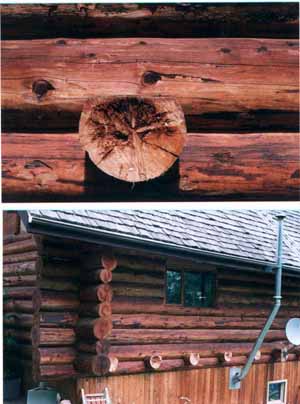Subject: Good wood but still leaks
Date: Fri, 28 Jan 2000We live in a square timber home. The timbers ("logs") are about 7" by 5" -- double tongue and groove -- but only spiked together and some logs have significant gaps between them.
I stripped the old stain and a restoration company caulked between the logs (due to leaks during heavy storms) and stained and resealed the entire house.
The wall that leaked most is now down to two or three leaks -- may all have the same origin.
We can't figure out where the water is coming from. From what we can see all upchecks are caulked securely, and even very small checks have been filled. Obviously we've missed something, but who knows what.
Here's what I'm thinking. I'll cover the top two thirds of the wall, and annoy it with a heavy stream of water from a garden hose. If the bottom third leaks, I'll lower the covering until I have a good idea where the leaks originate. Ideally I can get this down to a fairly small area.
If I can identify a small area that originates the leaks, do you think epoxy injection would seal out the water?
Any advice greatly appreciated.
Thanks.
Kim
We have a very happy customer who owns a wooden boat on the Chesapeake Bay. He used our CPES to seal a very persistent leak in the bow of his boat that no other product had been able to fix. If CPES can keep the Chesapeake Bay out of his boat, I imagine that it can do the same for your house. The trickiest part is identifying the leaks. Water using the method you described should certainly work. You would need to allow the wood to dry before using our CPES if you use this method. I might be tempted to try to form a vacuum inside the house with a strong fan in a window with all other doors and windows tightly sealed, followed by a large bundle of incense moved around the exterior of the wall. The sight or smell of smoke by someone on the inside of the wall would indicate the source of the leak. This would have the advantage of not wetting the interior of the log, allowing immediate repair. It would probably not work as well on smaller leaks. The water method should work better on the smaller leaks.
Once you identify the leaks you want to be sure that you seal them properly. CPES is an aggressive penetrant, and will go through the smallest crack or crevice. I would keep applying the CPES to the crack in question as long as it seems to be disappearing into the bottom of the crack. Watch for the CPES to leak out in other areas. If it starts to leak out, stop filling the crack and try again after the first application has had a chance to dry. As you can see from the accompanying picture, there can be multiple channels inside the log. Completely sealing a crack may take several "apply and let cure" cycles. I would then caulk the crack with 3M's 5200 marine caulk. It is available in either tan or mahogany color, and provides a strong flexible seal for 20 years.

Please let me know if you have any further questions.
Doc